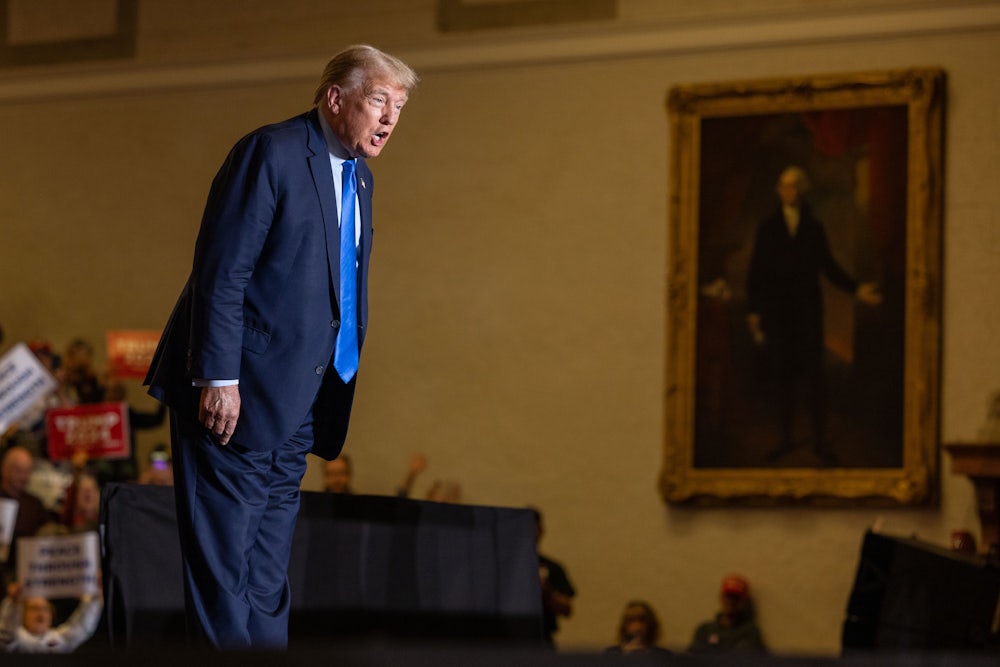In the late spring, the Club for Growth, the conservative organization that has spent more than two decades excommunicating any Republican it deems insufficiently committed to the sacred cause of cutting taxes and starving the welfare state, began airing ads aimed at taking down Donald Trump. That his signature—and arguably only—legislative achievement during his four years in office was a massive corporate tax cut hardly seemed to matter. Never a doctrinaire supply-sider—and now campaigning against several Republicans whose primary focus was slashing spending and taxes to the rich—Trump was simultaneously committing multiple cardinal sins: advocating for tariffs and, most egregious of all, promising to protect Social Security. (To be fair, Trump has also backed and campaigned for several candidates who want tax and spending cuts and could hardly be considered fiscal doves. Additionally, the Trump administration proposed cutting Social Security in his 2021 budget.)
“The Trump plan for Social Security is no practice swing,” the ad reads over footage of Trump swinging a golf club. “His plan—same as Joe Biden’s—would club seniors with automatic benefit cuts, 23 percent in 10 years or less, putting your retirement in a rough spot.” It’s a short, tricksy ad: It never mentions that the Club for Growth has been a leading proponent of cuts to Social Security since its inception in 1999.
Over the summer, Win It Back, a political action committee tied to the Club for Growth, spent millions airing this and more than 40 other anti-Trump ads in Iowa and South Carolina. It didn’t work. In September, the Club for Growth’s president, David McIntosh, acknowledged to donors that “all attempts to undermine his conservative credentials on specific issues were ineffective.” It was a stunning admission and an unsurprising one at the same time. It was also one that revealed just how much influence the Club for Growth—and, by extension, the anti-tax, anti-spending wing that has dominated the conservative movement for more than four decades—has lost.
The relationship between Trump and the Club for Growth was fraught from the beginning. In 2016, the conservative group also spent heavily on ads that were highly critical of the presidential candidate’s record on trade, taxes, and bailouts. “There’s nothing conservative about supporting socialized single-payer health care,” went one ad the group ran. “There’s nothing conservative about giving money to the Clintons. There’s nothing conservative about Donald Trump.” The Club for Growth backed Ted Cruz—its first-ever presidential endorsement. When his campaign crashed and burned, the group sat out the rest of the election. This was hardly surprising, given the group’s single-minded, pugilistic nature: Founded in 1999, it had long exerted influence over the GOP by force, spending heavily to push out any Republican who did not commit to drastic cuts to taxes and spending. The group was centered around pushing out moderate Republicans and replacing them with draconian fiscal conservatives.
Trump’s hostile takeover of the Republican Party was, in some ways, a culmination of that mission, a reflection of just how far-right the Republican Party had become. But Trump also outflanked them. Closely aligned with the arsonists of the hard-right House Freedom Caucus, the Club for Growth was the epitome of the GOP’s anti-establishment establishment, harnessing populism to push policies that benefited corporations and the wealthy. Now, the Tea Party-aligned group was passé: Donald Trump represented a newer, harder-edged, and more chaotic alternative.
As happened with many conservative and establishment groups, the Club for Growth made peace with Trump after his surprise election in 2016. And, as with many conservative and establishment groups, the Club for Growth was hoping to play Henry Higgins to the new president’s Eliza Doolittle. “David viewed his partnership with Trump as a way to help steer the Trump team to more conservative, free-market candidates,” Marc Short, an aide to Vice President Mike Pence and close ally of the Club for Growth, told The Washington Post shortly before the 2022 midterms.
The subsequent alliance was beneficial to both parties. The Club for Growth helped push for Trump’s massive, multitrillion-dollar tax cut, a quintessential supply-side, “trickle down” bit of legislation that lowered the corporate tax rate from 35 percent to 21 percent. (Six years after that bill was signed into law, its spoils have hardly trickled down; indeed, many corporations used the subsequent windfall not to invest but to buy back stock.) Trump, meanwhile, got a pugilistic, deep-pocketed group willing to spend millions to back far-right candidates. Trump’s advocacy for tariffs and his trade war with China—the Club for Growth has opposed protectionist policies for years—hardly mattered. This was, in many ways, characteristic of the “if you can’t beat him, join him” approach taken by many conservative groups: The Club for Growth saw Trump’s status as a political neophyte as an opportunity to influence him.
The alliance between the two began to crack during the 2022 midterms, however. During those elections, the Club for Growth and Trump found themselves on the opposite end of several successive primaries, backing rival candidates in Pennsylvania and Ohio. When the Club for Growth refused to follow Trump’s lead after he endorsed J.D. Vance in Ohio, the former president was furious, ordering an aide to text McIntosh “go fuck yourself.”
Once again, economic policies were at the center of the feud, particularly over tax and entitlement cuts and tariffs. But it also represented a larger rift between Trump and conservative groups that had brokered shaky truces with him in 2016. Then, Trump desperately needed outside help to staff and run a presidency he was ill-equipped and ill-prepared to manage; he also needed to broker alliances with groups on the right to help withstand the ferocious opposition his presidency would receive from Democrats. Once in office, however, Trump frequently clashed with establishment figures inside and outside his administration and chafed against their attempts to manage him. Preparing for a 2024 presidential run, he has surrounded himself with loyalists and lackeys who are bent on forming an administration built entirely around Trump’s own bleak vision for the country.
In contrast to 2016, Trump’s hold on the Republican Party now seems secure. With a massive lead in nearly every state and national poll of GOP voters, he doesn’t have to bend the knee to anyone. Those who attempted to manipulate the former president have become targets. “David got pretty swept up in all the stuff. He got in pretty deep,” one source with close ties to the club told the Post last year. “Maybe he thought he was playing Trump. There’s a chance he thought he was smarter than Trump. It obviously didn’t work.”
For decades, the Club for Growth had used its massive financial clout—it spent $150 million in the 2020 and 2022 elections—to exert influence over the Republican Party. In 2023, the money is still there. To be fair, congressional Republicans—thanks in part to that spending—are as committed to its mission of cutting spending and entitlements as ever. And yet, the club’s influence has significantly waned. Immigration and cultural issues have surpassed government spending as the causes du jour of the GOP. The relationship between Trump and McIntosh—and by extension the Club for Growth—seems to be broken beyond repair. Should Trump reenter the White House in January of 2025, he will almost certainly have a new set of economic advisers and an old set of priorities, many of which are at odds with those the club has advocated since its inception.
The Club for Growth was once at the forefront of the Republican Party’s emphasis on rigid adherence to dogma over electability. It still is, pushing candidates with extremist economic beliefs in races across the country. It has, similarly, backed Governor Ron DeSantis—once a Tea Party Republican in Congress—over Trump in the 2024 primary. In the aftermath of Trump’s election, the GOP’s apathy toward electability remains, but the dogma has changed. What’s more, the club’s efforts to break Trump’s hold on the Republican Party have actually backfired: Ads emphasizing Trump’s deviations from conservative orthodoxy and his indictments have made the former president more popular among GOP voters.
In September, having spent millions on ads aiming to damage the former president’s standing among GOP voters, McIntosh, who also heads Win It Back, admitted the effort had failed catastrophically. “Even when you show video to Republican primary voters—with complete context—of President Trump saying something otherwise objectionable to primary voters, they find a way to rationalize and dismiss it,” McIntosh wrote in a memo to donors.
“Every traditional post-production ad attacking President Trump either backfired or produced no impact on his ballot support and favorability,” he continued. “This includes ads that primarily feature video of him saying liberal or stupid comments from his own mouth.”
To some extent, the Club for Growth’s diminishing influence reflects its hubris: the belief that its money and power made it untouchable; the belief that it could help control a candidate as chaotic and megalomaniacal as Trump. But it also shows the waning influence of supply-side economics within the Republican Party itself.




